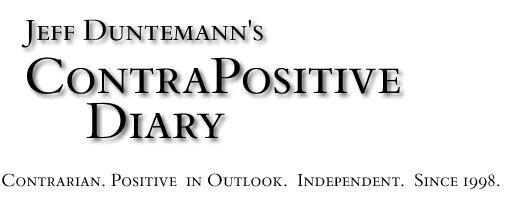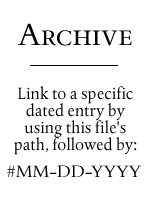|
|
|

|
 May
30, 2008: Odd Lots May
30, 2008: Odd Lots
- Wired aggregated this
item about a convertible bus/railcar that somehow suggests
a modern take on the legendary Rio
Grande Southern Galloping Goose lashups. I like the concept
a great deal, especially for rapid transit in places where there
are rails but not enough population density to create a dedicated
passenger rail system. The technology is hardly original with
Japan; I see Union Pacific maintenance pickup trucks riding the
rails all up and down the old Northwestern corridor outside of
Chicago every time I'm in town. The trucks straddle the tracks
at a grade crossing, drop their flanged steel wheels, and then
apply traction from the truck's rear rubber tires. I don't see
why a passenger bus of some sort couldn't do the same thing.
- I don't recall when someone asked me this (or, in truth, who
it was) but the decorative font used on the cover of the Degunking
books for the main titles is the Chicken
King font from Font Diner.
The similar decorative font used in the main chapter titles is
Fontdinerdotcom
Loungy. Font Diner is a type foundry that specializes in retro
fonts, and they have a bunch of them, generally sold in 10-font
packs for $28.
- My uncle ran a dairy farm in Wisconsin until 1975 or so, and
in addition to milk, his herd produced a mid-boggling (to me,
at least) quantity of cow manure. Finally we have a
small-scale mechanism for harvesting the methane produced by decaying
manure. The consolidation of small dairy farms like my uncle's
into monster corporate milk producers makes something like this
not only economical but pretty compelling.
- What the open source world needs is a sort of integrated bootloader
system as good as or better than Apple's BootCamp.
I've been hearing about GRUB2
for a long time, but it doesn't seem any farther along than it
was a year ago. Coreboot/FILO
is another interesting idea, but as I read it would require close
cooperation of PC hardware manufacturers—which would be a
good thing, fersure, if it would happen. (That may be the big
trick.) I'm considering the commercial Bootit
NG for my next machine, but in the open source world I don't
see a lot happening. If I'm missing something, do let me know.

|
 May
28, 2008: Kubuntu on Painkillers May
28, 2008: Kubuntu on Painkillers
A quick update on my mouth rehab, though it borders on TMI: About
two weeks ago I had 30 new crowns installed, after fussing with
a mouthful of temps for most of a month, one of which had a bad
habit of coming loose while I was doing something innocuous, like
chewing a chicken leg. That operation was not bad, though my gums
got a little beat up from the sterilizing agent and dental pick
work to remove excess adhesive. So now I have 30 brilliant white
porcelain crowns, and if all you look at are my teeth, well, I look
like a TV anchorman.
But that leaves two to go. One of them was so badly damaged by
six years under my previous horseshoe of connected crowns that it
had to come out. The other is a healthy tooth but needed crown lengthening
and a post in the middle of it, because it had gotten whittled down
so far in 2001. Alas, a post requires a root canal, because the
post has to go somewhere. Yesterday I went back and had the lower
molar pulled, and crown
lengthening (warning: NSFS) done on its opposing number in my
upper jaw. That involved some bone scraping, which was one of the
ugliest sounds I've ever heard, given that I could feel it in my...bones.
Everything becomes quiet for about six months now. My empty socket
has to heal and fill in with bone, after which the surgeon will
install an implant post to hold a porcelain molar. At about the
same time, I'll have a root canal done on the upper and a post installed
in the middle of that tooth to hold the opposing porcelain molar.
And then—egad, I hope!—the whole thing will be finished.
On the other hand, I thought I was finished in 2001. Silly boy.
So I'm back on painkillers, though I don't need as many this time
as when I had my gums reworked along the entire perimeter of my
lower jaw back in January. And last night I did an interesting experiment:
I installed Hardy Heron not once but twice, all while in a codeine
fog.
Results: It went flawlessly. Linux has clearly arrived. A week
or so back I downloaded and burned the ISOs for both Ubuntu and
Kubuntu 8.04, the Kubunto distro with KDE 4. I like KDE more than
Gnome, because it reminds me more of Windows, and I've been looking
forward to seeing V4 for several months. Both Ubuntu and Kubuntu
installed without incident, each in its own 30 GB partition on my
lab SX270 3.2 GHz box. I did not have the
display glitches I had back in October, (even though the hardware
has not changed at all) and both distros saw my network immediately.
I installed a bunch of things with the Adept installer, including
some games, Boa Constructor (a vaguely Delphi-ish RAD environment
for Python) and some office apps. No problems there, and Boa Constructor
is worth a little experimenting and some description as time allows.
My only complaint so far is a minor one: GRUB is ugly, and needlessly
so. Suse and Fedora (I think) already have a graphical GRUB OS selection
screen. Given the importance Ubuntu places on nontechnical users,
I think it would be worthwhile to budget a little work for creating
one and including it in the default distros.
The reasons are not entirely esthetic. Nontechnical people almost
never see text screens anymore (except for a vanishingly quick appearance
while BIOS POST does its thing) and when they do, it almost always
means that something is wrong. Leaving a general good impression
of desktop Linux is vital right now, as from what I can see, the
OS itself is ready.
A quick skim of the Ubuntu forums online indicates that it's possible
to install a graphical GRUB display in Ubuntu, and I'm going to
give it a shot today or tomorrow, when the codeine is no longer
necessary and I can run my brain on all cylinders. In the meantime,
if any of you have any experiences (good or bad) with graphical
GRUB displays, I'd appreciate hearing them.

|
 May
26, 2008: The Canon G9 Camera May
26, 2008: The Canon G9 Camera
 Our
neighbors Lena Olson and David Kuchinski came by for dinner last
night, and Lena brought her Canon G9 digital camera. I've been looking
for the successor to my well-used Kodak V530, and the G9 is an extremely
impressive item. I was thinking that to get all of what I wanted,
I would have to stay small and also go big, all the way up to a
Digital Rebel SLR or something like it. The G9 falls somewher in
the middle, and is about the same size and heft as the compact 35mm
film cameras that Carol and used in the 80s and 90s. Our
neighbors Lena Olson and David Kuchinski came by for dinner last
night, and Lena brought her Canon G9 digital camera. I've been looking
for the successor to my well-used Kodak V530, and the G9 is an extremely
impressive item. I was thinking that to get all of what I wanted,
I would have to stay small and also go big, all the way up to a
Digital Rebel SLR or something like it. The G9 falls somewher in
the middle, and is about the same size and heft as the compact 35mm
film cameras that Carol and used in the 80s and 90s.
I have some complaints about the V530, but it slips easily into
my pocket and is all-metal on the outside, which is good if it's
sharing the pocket with my keys and my usual quarter-pound of loose
change. The V30 is great if you're going walking and want to catch
the elusive Colorado wild turkeys that I seem to see only when I
don't have a camera in my pocket. (Local
bears are not as shy.) However, I do need something with more
control over exposure, a somewhat better flash, more battery life,
and (especially) better macro capability.
One of the things I want to do is take better pictures of smallish,
small, and very small objects. Not microscopic objects—just
things down, perhaps, to the size of a quarter. The V530 can focus
on things that small, but its depth of field isn't good, its auto
focus feature sometimes focuses on the wrong part of the artifact,
and exposure control is poor for anything at macro range.
Lena is an award-winning
sculptor, and artistic in ways I can never hope to be. I trust
her judgment about artist tools generally, including cameras. She
thinks the G9 is the best camera she's ever tried—and after
I explained what I was looking for, she declared it just the thing
and left it with me for a couple of days to see for myself. I took
a few test shots with it this morning out on the back deck (where
the diffused light of a mildly cloudy day was especially good) and
am much impressed.
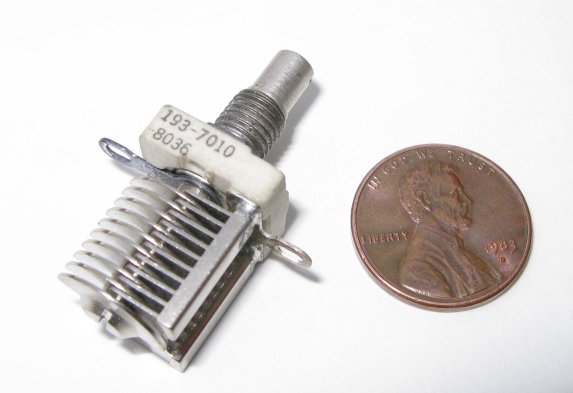
This was taken without knowing anything at all about what can be
done with the camera's special options, and at least for Lulu projects,
I consider it publication-quality. I want to see about increasing
the depth of field while reducing shadows, but what I got was probably
good enough.
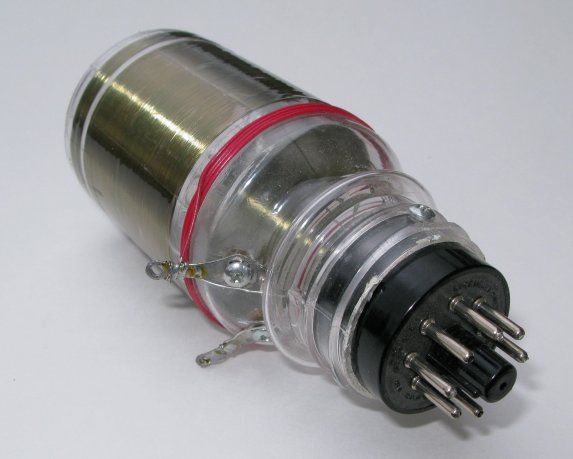
The photos I show here (both taken this morning) don't really put
across how much detail is present in the digital files, which in
their native mode are 3000 X 4000 pixels in size. You can zoom in
until you fill the screen with an octal tube socket, which (for
tube geeks like me, at least) was mighty surreal.
It's not significantly more expensive than the V530 was a couple
of years ago (about $400 online) and looks like it will do the job.
We'll see.
As an aside, I'm going in tomorrow morning to get a tooth pulled
and the socket bone-grafted. The surgeon is also going to trim the
gumline around the opposite molar. I'm likely to be under a fog
all day tomorrow (and perhaps part of Wednesday) and may not post
for a few days. Man, this dental project is getting old.

|
 May
25, 2008: Odd Lots May
25, 2008: Odd Lots
- Someone's invented a
glass jar with a screw-on lid on both ends. Makes sense: By
the time you reach the bottom of the peanut butter, most of the
oil is gone and what's left is as hard as a rock. Or, alternate
lids and gradually work your way toward the middle. If you keep
alternating which end is up, the oil won't be as likely to collect
on either end and the peanut butter may stay softer until it's
all gone.
- Bruce Baker directs us to a
Webring of homebrew CPUs. No VLSI. No LSI. Maybe TTL chips.
Or discrete transistors. Or relays. I wire-wrapped a COSMAC machine
with 2K of RAM back in 1977, and I thought it was a job. Wow.
- As an individual with a "special relationship" to
calculus (and a special fondness for filk) I damned near bust
a gut watching this.
The Slashdot commenters (who are interesting all by themselves)
need to get a life, or at very least a sense of humor. Most of
them weren't even alive when Disco was first-run, and so I suspect
the comedy shoots right by them.
- Epson has been demonstrating a proof-of-concept model of an
A4-sized e-ink display with a mind-boggling resolution of
3104 X 4128 pixels, in monochrome. 385 DPI is more than enough
for monochrome graphics (though gray-level depth is not stated)
and within a few years, a full-sized letter/A4 ebook reader will
not only be possible but inevitable.
- From Jan Westerlink comes a pointer to a
wonderful gallery of home-made kites, including one I especially
like, especially in light of yesterday's entry: A 4-cell tetrahedral
made by rubber-banding 24 bamboo shish-kebob skewers together.
Scroll down to pictures 24 and 25. Beautifully done, if a little
prickly: If that thing dives toward you, duck!

|
 May
24, 2008: The D-Stix Kite Flies Again! May
24, 2008: The D-Stix Kite Flies Again!
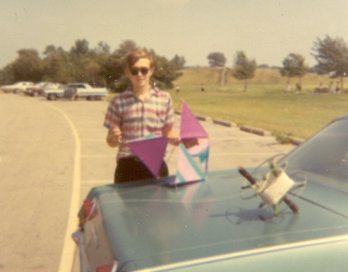 As
we concluded our first date back on July 31, 1969, I somewhat apprehensively
asked Carol if she would go out flying a kite with me on the following
Saturday. I was building a tetrahedral kite out of my D-Stix set,
and although my intuition was that this was not the way to
impress girls, I gave it a shot, and she accepted. And so it was
that we piled into my mom's '65 Biscayne and took my D-Stix tetra
out to the huge Forest Preserve field at Irving Park Road and Cumberland. As
we concluded our first date back on July 31, 1969, I somewhat apprehensively
asked Carol if she would go out flying a kite with me on the following
Saturday. I was building a tetrahedral kite out of my D-Stix set,
and although my intuition was that this was not the way to
impress girls, I gave it a shot, and she accepted. And so it was
that we piled into my mom's '65 Biscayne and took my D-Stix tetra
out to the huge Forest Preserve field at Irving Park Road and Cumberland.
The kite didn't fly well, if I recall correctly (and in truth,
most of what I remember about that Saturday afternoon was Carol)
but we both had a great time. An hour or so in, the kite smashed
into the ground and broke a couple of sticks, but I salvaged the
yellow connector pieces—and when I recently pulled down the
butter dish that the D-Stix connectors had been in since who knew
when, begorrah, they were still in there, including one with some
kite string still tied through the hole.
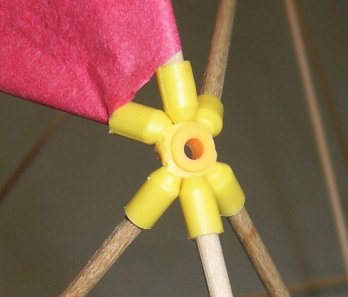 It
was a natural. I took the same damned D-Stix pieces, bought some
1/8" dowels, and I made us another tetrahedral kite. At some
point I will create a Web page describing its construction in detail,
but I'll just insert a few photos here. A typical joint is at right.
The yellow connector originally had eight "ears," but
I snipped two off with a dykes to make the requisite six. (The four
outer vertices were six-bangers from which I snipped three.) The
paper was ordinary Hobby Lobby artsencrafts tissue, which I glued
with Elmer's glue. Mucilage would be better—or at least more
historically accurate—but they don't sell that at Hobby Lobby
anymore. It
was a natural. I took the same damned D-Stix pieces, bought some
1/8" dowels, and I made us another tetrahedral kite. At some
point I will create a Web page describing its construction in detail,
but I'll just insert a few photos here. A typical joint is at right.
The yellow connector originally had eight "ears," but
I snipped two off with a dykes to make the requisite six. (The four
outer vertices were six-bangers from which I snipped three.) The
paper was ordinary Hobby Lobby artsencrafts tissue, which I glued
with Elmer's glue. Mucilage would be better—or at least more
historically accurate—but they don't sell that at Hobby Lobby
anymore.
Building the kite didn't take much doing. I assembled the D-Stix
frame, cut out some conjoined equilateral triangles of tissue, and
glued the tissue to the frame. There were a couple of tricky glue
joints, but nothing that a protruding corner of a chunk of plywood
didn't finesse. All in all, it took maybe an hour.

And it flew. Sorta. Carol and I got it into the air down at the
park along Highway 115, but the wind was strong and erratic and
I had to hang some tail on it to keep it aimed skyward. It had a
tendency to lean left, and after a few minutes of tearing around
the great blue sky like a puppy suddenly released from its kennel,
it did The Dive, and mashed itself against the grass just like its
previous incarnation had, almost 39 years earlier. Two sticks popped
out of their sockets, and the tissue ripped into two places, but
it's nothing a clever geek can't fix.

It was beautiful. (And weird.) Just like Carol (and me.) We laughed,
and laid back in the grass, and reflected that life can be good
on a brisk Saturday, with a kite and some string and a willingness
to let all the rest of it just blow away for awhile.

|
 May
23, 2008: The Risks of Quirky English May
23, 2008: The Risks of Quirky English
As I've mentioned here a time or two, I've been gradually recasting
my 1993 book Borland Pascal 7 From Square One for the current
release of FreePascal.
It's turned out to be a larger project than I had expected for a
number of reasons, some of them humbling (I was not as good a writer
in 1984 as I am today) and some completely unexpected. The one that
came out of left field stems from the fact that Pascal isn't used
in the US that much anymore. Most of the audience for the new book
is in Europe, and while most of them understand English, they understand
correct, formal, university-taught English.
Not slangy, quirky, down-home, Jeff Duntemann feet-up-on-the-cracker-barrel
English.
This became clear some time back when I posted the first few chapters
for FreePascal users to look at. I got a few emails with detailed
critique (for which I am extremely grateful) and there was a certain
amount of puzzlement about some of the language. A few of the things
that puzzled my European friends were not a surprise:
- QBit stretches and climbs on my chest, wagging furiously as
though to say, "Hey, guy, tempus is fugiting. Shake
it!"
- Ya gotta have a plan.
- ...and write the plan in German, to boot.
- ...cats are pets, not hors d'oerves on the hoof.
But some were. The expression "to run errands" is not
universally understood there. Nor is the word "shack."
(I changed it to "shed.") I want very much for the book
to be accessible to those who are using Pascal the most, and that's
a new kind of challenge for me: Writing plain English without resorting
to clever coinages and Americanisms.
Alas, I'm not always aware of it when I'm using Americanisms. (I
should find a book for English-speakers traveling here, just as
there are books on British English for those of us who visit the
UK.) There are other problems: Europeans are not intuitive with
Fahrenheit temperatures, any more than we're intuitive with Celsius
here. I mentioned in the book that it hit 123° in Scottsdale
once in the summer of 1996, and although my European friends know
that that's hot, when I translate it to Celsius—50°—they
gasp. We were gasping too—Keith and I had to shut the Coriolis
offices down because the air conditioners were losing the race.
Solution: Put temps in Celsius. Americans know damned well how hot
it is in Scottsdale. (As I left in 2002, it seemed like most of
them had already moved there.)
It's a two-edged sword. I like writing the way I talk, and for
those who haven't met me, well, I talk the way I write. It's easy.
On the other hand, having worked my way through the first hundred-odd
pages of the new book, straightening out my language quirks, I find
that it reads very well. It doesn't sound quite as much like me,
but that's OK. The idea is to keep Pascal alive, wherever and however
it is to be done. Writing for the world—and not strictly for
us American barbarians—is a useful skill and good discipline.
If I stick with Pascal and Delphi, which I have every intention
of doing, you're likely to see more of it in the future.

|
 May
20, 2008: Odd Lots May
20, 2008: Odd Lots
- Most people know that the New Age Millerites believe that the
world is going to end on December 21, 2012; if that's news to
you, here's a
nice overview of this deliciously deranged topic, courtesy
Frank Glover.
- Several people online, in an almost offhand fashion, have indicated
that Vista's knucklehead UAC feature is training people to click
"Allow" automatically, no matter what it's asking
about. That may be the single greatest design error in Vista,
and could over time render Vista as insecure as anything that
came before it, and certainly less secure than just working in
an LUA under XP.
- A reader has asked me to post an entry on all magazines to which
I have subscribed and re-upped at least once, but no longer subscribe
to. That would be an interesting collection, and a long entry,
but I'll try and get to it soon. One of that group that I might
still read if I had enough time is First
Things.
- I had a tin toy robot when I was six or seven, and it seems
like most of my friends had one or two. So it was a Boomer kid-culture
phenomenon, and one I don't see much about these days. Here's
a
photo gallery from Wired with some nice shots. Most
of my early childhood nightmares were about robots and mummies,
which suggests that my two subconscious fears (at least according
to one amateur Jungian friend of mine from twenty-odd years ago)
were of death and berserk machinery. I'm not so sure; that was
what most of the cheap horror/sf flicks I saw on Channel 7 were
about at that time.
- Another interesting
article/discussion on the Fermi Paradox. Me? I think we really
are alone. I don't know why just yet. If I had to guess, I'd say
that it's because imagination as a mental mechanism is rare. But
I've been thinking about this for thirty years and keep coming
back to that conclusion.
- Lordy, I remember these
from catalogs back in the early 60s. Why do they suggest a filk:
Looking Through the Eyes of Badminton! (Thanks to Bishop Sam'l
Bassett for the pointer.)

|
 May
19, 2008: Magazine Meanderings May
19, 2008: Magazine Meanderings
We brought home two weeks' worth of mail this afternoon, and in
the pile were the latest issues of all the print magazines I currently
subscribe to: QST, Nuts & Volts, The Atlantic,
and Wired. Every month I read them—or major portionsof
them—and every month I fret for the future of the magazine
business, in which I played with great success for fifteen years
(1985-2000.)
QST isn't doing too badly. It looks pretty much the way
it looked twenty years ago, and it fulfills its editorial mission
better than any magazine I've seen in recent times. The amateur
radio demographic isn't doing well, as our average age is now up
in the high 50s somewhere, but the editorial people know their readers,
the ad people know their advertisers, and somehow they make it work.
I just wish they'd publish a review—or simply an announcement!—of
my Carl & Jerry reprints.
And I continue to be amazed at how well Nuts
and Volts has grasped what Tim O'Reilly has brilliantly
nailed as the Maker Psychology: People who build stuff because they
love to build stuff, whether it actually turns out to be useful
or not. It's the last real big-time magazine about electronics,
and I bought a lifetime subscription in 1980 for $5! I just wish
they'd publish a review—or simply an announcement!—of
my Carl & Jerry reprints. (Is there an echo in here?)
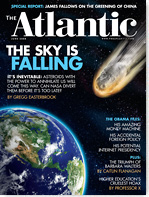 I'm
not as sanguine about The
Atlantic, and haven't been for five or six years now. Still,
every time my sub runs out, I re-up, having been wowed by an article
or two right in the nick of time. They used to publish thought-provoking
articles about things I hadn't heard about before, or didn't understand,
or both. A couple of issues ago, they published a cover story about...Britney
Spears! The readership apparently sent away (from one of those wonderfully
eccentric little 1/12 page ads in the back of the mag, doubtless)
for authentic Transylvanian torches and pitchforks and began marching
on the mag's offices on New Hampshire Avenue in DC. Me, I'll be
contrarian here and say that Britney didn't bother me too much.
Maybe she was an experiment. Maybe the editorial staff wanted to
prove to their bean counters that slutty, washed-up pop singers
are not the keys to the kingdom; if so, they succeeded in spades.
No, my big gripe with The Atlantic is that they became obsessed
with political personalities a few years back, and now it's Obama
or one damned Clinton or another on the cover almost all the time.
I wouldn't mind articles about political ideas so much, but no—it's
all about how desperate Hilary is getting, and how Obama will learn
how to walk on water by his inauguration next January. (Hint: Pray
for a winter cold enough to freeze the Potomac.) I was ready to
let it lapse back in January, and then they published Lori Gottlieb's
brilliantly ascerbic little spitting-into-the-evolutionary-wind
commentary called "Marry
Him!" I re-upped. And this month, mirabile dictu!
Their cover story is a reasonable layman's overview of threats to
the Earth from asteroids and comets. There's the inescapable praise-for-Obama
piece and a peculiar backhanded tribute to G. W. Bush, both of which
I could have done without, but there was also an anguished piece
by an adjunct professor teaching English to night school students
tellings us that not everyone has what it takes to get a college
degree. We'll see who wins come next January when I have to
write another check, but my editor's intuition detects a back-office
struggle between editors who think we like to read about ideas and
editors who think we like to read about, um, our national mental
illness. Hey, guys, John-John Kennedy himself couldn't
make it work. Whatthehell makes you think you can? I'm
not as sanguine about The
Atlantic, and haven't been for five or six years now. Still,
every time my sub runs out, I re-up, having been wowed by an article
or two right in the nick of time. They used to publish thought-provoking
articles about things I hadn't heard about before, or didn't understand,
or both. A couple of issues ago, they published a cover story about...Britney
Spears! The readership apparently sent away (from one of those wonderfully
eccentric little 1/12 page ads in the back of the mag, doubtless)
for authentic Transylvanian torches and pitchforks and began marching
on the mag's offices on New Hampshire Avenue in DC. Me, I'll be
contrarian here and say that Britney didn't bother me too much.
Maybe she was an experiment. Maybe the editorial staff wanted to
prove to their bean counters that slutty, washed-up pop singers
are not the keys to the kingdom; if so, they succeeded in spades.
No, my big gripe with The Atlantic is that they became obsessed
with political personalities a few years back, and now it's Obama
or one damned Clinton or another on the cover almost all the time.
I wouldn't mind articles about political ideas so much, but no—it's
all about how desperate Hilary is getting, and how Obama will learn
how to walk on water by his inauguration next January. (Hint: Pray
for a winter cold enough to freeze the Potomac.) I was ready to
let it lapse back in January, and then they published Lori Gottlieb's
brilliantly ascerbic little spitting-into-the-evolutionary-wind
commentary called "Marry
Him!" I re-upped. And this month, mirabile dictu!
Their cover story is a reasonable layman's overview of threats to
the Earth from asteroids and comets. There's the inescapable praise-for-Obama
piece and a peculiar backhanded tribute to G. W. Bush, both of which
I could have done without, but there was also an anguished piece
by an adjunct professor teaching English to night school students
tellings us that not everyone has what it takes to get a college
degree. We'll see who wins come next January when I have to
write another check, but my editor's intuition detects a back-office
struggle between editors who think we like to read about ideas and
editors who think we like to read about, um, our national mental
illness. Hey, guys, John-John Kennedy himself couldn't
make it work. Whatthehell makes you think you can?
 And
then there's Wired.
Like the trademark alternating color bars on their spine, I subscribe
and lapse, subscribe, and lapse. The colors and the page layouts
still give me headaches, but to ensure that I'm still young
old (rather than old old) I have to keep in touch. And they have
their moments: The current issue's cover text is absolutely, unreservedly
brilliant: "Attention Environmentalists: Keep your SUV. Forget
organics. Go nuclear. Screw the spotted owl." I wanted to cheer.
And then I went right for the cover story, to receive the worst
impression that they had gotten the idea for the cover but then
chickened out when trying to create the article. A few hundred disjointed
words without much in the line of facts qualifies as a rant but
hardly an idea piece, and the tiny nuggets of information they tossed
in simply made me nuts to find the rest of the story somewhere.
In the meantime, what the current issue tells me is that in some
quarters, at least, our national mental illness is not politics
but ADD. There's almost nothing in the whole issue that's more than
a few hundred words long. Wired has for some time been approaching
what I might call "magazine theater": Giving the reader
the impression that they're reading a magazine. It's currently paid
for, but I think the bar on my spine is about to change colors again. And
then there's Wired.
Like the trademark alternating color bars on their spine, I subscribe
and lapse, subscribe, and lapse. The colors and the page layouts
still give me headaches, but to ensure that I'm still young
old (rather than old old) I have to keep in touch. And they have
their moments: The current issue's cover text is absolutely, unreservedly
brilliant: "Attention Environmentalists: Keep your SUV. Forget
organics. Go nuclear. Screw the spotted owl." I wanted to cheer.
And then I went right for the cover story, to receive the worst
impression that they had gotten the idea for the cover but then
chickened out when trying to create the article. A few hundred disjointed
words without much in the line of facts qualifies as a rant but
hardly an idea piece, and the tiny nuggets of information they tossed
in simply made me nuts to find the rest of the story somewhere.
In the meantime, what the current issue tells me is that in some
quarters, at least, our national mental illness is not politics
but ADD. There's almost nothing in the whole issue that's more than
a few hundred words long. Wired has for some time been approaching
what I might call "magazine theater": Giving the reader
the impression that they're reading a magazine. It's currently paid
for, but I think the bar on my spine is about to change colors again.
Still, consider the fate of Sky and Telescope, which I dropped
in February after subscribing for over twenty years, because I just
wasn't reading it. I took Harper's for a year back in the
late 80s. Now I riffle through it in airport newsstands to make
sure I'm not missing something. (I'm not.) And don't get me started
on Scientific American...
I love magazines. I guess I'm just fussy. But you knew that.

|
 May
16, 2008: A Gunk Issue with Eraser 5.7 May
16, 2008: A Gunk Issue with Eraser 5.7
I'm over at my sister-in-law Kathy's house, taking a look at her
Dell SX270 computer, which I installed here last summer. She asked
me to look at it because it had suddenly gotten sluggish, and I
was prepared to find viruses or spyware. Instead I found a 40 GB
hard drive that was 98% full, when the last time I was here it was
less than 50% full. That was mighty suspicious, and I ran TreeSizeFree
to tell me where all that file space had gone. It had gone into
a single folder under C:\ called ~ERAFSWD.TMP, which was hogging
a staggering 21 GB of disk space in many hundreds of very large
files.
The ~ERAFSWD.TMP folder, as it turns out, is created every time
the free Eraser
file shredder app begins an erasing run, and is deleted when
Eraser finishes. A week or so ago, the machine's video driver crashed
for reasons unclear, and had the bad karma to crash when Eraser
was doing its default daily scheduled run erasing unused disk space.
So Eraser had never released the temp space it allocated while it
was running.
The solution is simple: Exit Eraser (it's a tray app) and delete
~ERAFSWD.TMP. Then (to make it less likely to happen again) remove
the scheduled erase run, which is set up by default when Eraser
is installed. Eraser is most useful when emptying the Recycle Bin,
and installs a Recycle Bin context menu item for that purpose. Unless
you work with a great deal of confidential information, daily scheduled
free space erasing is massive overkill. I do a free space run on
demand every few months.
It was my own damned fault, as I had installed Eraser on this machine
last summer without removing the daily scheduled run. Sometimes
even a master degunker generates massive gunk. Mea culpa.

|
 May
15, 2008: UltraDefrag May
15, 2008: UltraDefrag
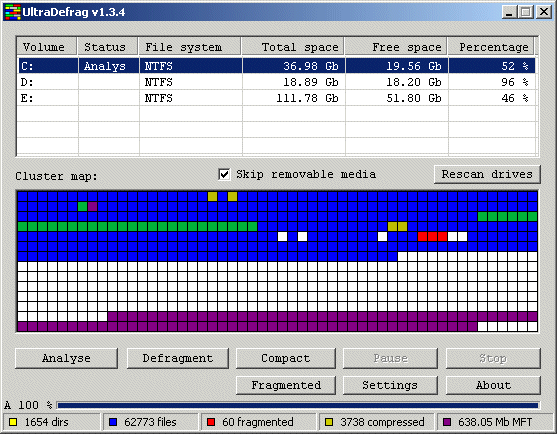
As part of my research for Degunking Essentials (basically
a condensation and updating of my three Degunking titles) I happened
upon a free disk defrag utility that's worth trying: UltraDefrag.
It's open source and hosted on Sourceforge, meaning it's safe—at
least if that's where you get it from.
The defrag utility built into Windows 2000 and XP is a crippled
version of Diskeeper.
It defrags but does not compact—that is, it does not
consolidate the defragmented files toward the low end of the hard
drive, and sometimes leaves a large number of contiguous files scattered
around on the drive. The commercial version of Diskeeper is quite
good and I bought it years ago, but UltraDefrag seems to do everything
Diskeeper does, and it's free. UltraDefrag compacts files, separating
files and free space. As an option it can also defragment the page
file at boot time, something I've never done. (I don't perceive
any increase in responsiveness having done it, though. I doubt it
has to be done very often.) The UI is less whizzy, but results are
what you're looking for, not flashy graphics. UltraDefrag is small,
simple, reasonably fast, and easy to use. Get
it here. Highly recommended.

|
 May
13, 2008: Odd Lots May
13, 2008: Odd Lots
- Sorry for the recent quietude here; the weekend was a whirlwind,
and it took all of yesterday just to catch my breath.
- Scott Kurtz' PvP webcomic celebrated its first ten years by
showing us that Brent
Sienna actually has eyes. Wow.
- Allan Heim sent me a pointer to a
nice article on the Fermi Paradox that expresses a position
I have been drifting toward for most of my life: That we are probably
alone in the universe, perhaps not only as intelligent, tool-building
beings but also as living things, period. The author makes a case
that being alone in the universe would be very good news, but
not for the reason you might think. Read it.
- Borland
is apparently selling their CodeGear division (which develops
and supports Delphi) to Embarcadero
Technologies, a database tools company. This was not unexpected,
and to be honest with you, I can't tell if it's a good idea or
not. One of Delphi's most serious problems is that it got so good
after five or six years that most people stopped upgrading; I'm
amazed at how many people are still using Delphi 6. The cost of
the product was also an issue—there is no ~$100 starter edition—and
the Turbo Delphi Explorer experiment demonstrated how important
the ability to install components was. An amazing number of people
wrote to me to say that they downloaded the free product, installed
it, fooled with it for a week or so, and then went back to Delphi
6.
- From Mike Sergent comes a pointer to a
NYT piece indicating that most people do not have the training
to discern the level of subtlety in wine flavor that they
claim to, and that a lot of it may exist mostly in our heads anyway.
This is not news (to me, at least) but it's nice to see it going
mainstream.
- Michael Covington posted a
fascinating graph of changes in home prices from Q4 2006 to
Q4 2007, suggesting that the "housing bubble" has not
been evenly distributed. The coasts have suffered, as have most
major cities and trendy places like Colorado's Front Range, but
flyover places like Nebraska and Wyoming have posted solid increases
in that time. In addition to that, sharp differences by state
suggest that state-level housing and banking policies have more
to do with housing cost changes than most people are willing to
admit.
- Also from Michael is a
graph demonstrating that the US economy is not as much of a disaster
as Big Media has been hammering on. (I won't invite all the
usual hate mail by explaining in detail why this is, as it's pretty
obvious if you think about it.)
- The other day I found myself thinking something remarkable (for
me): I would rather buy a Mac and run my essential Windows apps
in a Parallels window (or in a compatibility box like Crossover)
than move to Vista.

|
 May
8, 2008: Meeting Juliana Leigh Roper May
8, 2008: Meeting Juliana Leigh Roper

Bill & Gretchen returned home from Madison yesterday
with their new baby, Juliana Leigh. They were a little ragged from
the stress of the adventure and spending almost a week in a hotel
room, but the payoff was difficult to calculate: the little girl
sleeping on Gretchen's shoulder. Mission accomplished: Julie is
home.
Gretchen dropped her in my lap and I held her for
a little while, Gretchen
having made sure that her diaper was correctly applied and (as best
she could tell) tight. Julie looked around for awhile and squirmed
a little, but mostly she wanted to fall asleep. Like her sister
Katie before her, she is a very placid and un-fussy baby. I heard
her cry some when Gretchen changed her diaper a little later, but
apart from that she took it easy on Gretchen's shoulder. She lay
quietly in her magic stroller (magic in the way it folds down to
nothing and slides behind the seats in their van) while we had supper
at Sweet Baby Ray's, even with all the fuss that the waitresses
were making over her. Being six days old, she still has the ruddiness
of complexion that one expects of newborns, and the pale blue eyes
that most infants have before their pigment develops. Bill has blue
eyes. Gretchen's, like mine, are very brown. Julie's could still
go either way.
Nothing more to offer this morning than that. I'm
working on Degunking Essentials as I have for the last few
days, and will rejoin Carol later today. Tomorrow we launch south
to Champaign to witness our younger nephew Matt graduate from the
U of I, and with no crisp idea of my free time or connectivity,
it's hard to know when I'll post again, but don't despair if you
don't see anything before Monday.

|
 May
7, 2008: Odd Lots May
7, 2008: Odd Lots
- Here at the condo this morning, I can't bring up squat on the
Web because everybody's out there trying to figure out who won
the Democratic primaries last night. So I did an absolutely unheard
of thing: I went down to the White Hen, got some of their great
coffee, and picked up a newspaper. What a notion.
- I'm hearing more and more people say that Wi-Fi doesn't work
as well as it used to, which is weird because microwave physics
hasn't changed recently. But...look at how many APs Windows can
see from wherever you are. From my kitchen table here, NetStumbler
sensed twelve APs...and walking around inside our dinky
little condo picked up four more. Three of the strongest signals
were on default Channel 6—and five out of sixteen were cleverly
named "linksys." I don't think it's the physics, folks.
- After Meetup.com went all-paid (and highly paid) I investigated
an alternative called Gatheroo, which later (in response to another
damfool lawsuit from somebody) became Zanby.
The
site's been redesigned and is worth a look if you want to
start a meatspace social network where you live. There are both
free and paid levels of participation, and it's certainly not
as expensive as Meetup.
- Matthew Reed
(and lots of others after him) sent me pointers to articles about
the
recent implementation of memristors, which are a species of
passive electronic component postulated in 1971 but not actually
implemented until HP researchers made some earlier this year.
Whether this interests you varies directly by the strength of
your passion for electronics, and whereas I understand the concept
now, my head is still spinning trying to figure out what it implies.
Everybody's talking about better computer memory, sure...but what
could this do in simple analog circuits?
- Jim Strickland sent me a pointer to a
YouTube video about a flame triode amplifier/oscillator lashup,
and guys, you gotta see this. It's basically a vacuum tube without
either vacuum or tube: When the electrodes get hot, it starts
amplifying. I don't fully understand the physics yet, but this
would be one fantastic high school science fair project.
The question arose in our local group as to whether this could
be considered steampunkish, and I'm not sure. People in the steampunk
era had no problems generating reasonably hard vacuum and blowing
glass envelopes. What they had problems with was understanding
electrons. Nonetheless, with a big enough flame and some honkin'
batteries, you could have done some impressive things back in
1888.
- Global Cooling adherents have been sending me pointers to Watts
Up With That, and Icecaps.us.
Fascinating reading, including numerous facets of the climate
change discussion that you won't see in Big Media. F'rinstance:
Weather monitoring installations that were built sixty or seventy
years ago out in the leafy countryside have recently become surrounded
by new development, buildings, pavement, etc., and as a result
are now in the middle of heat islands. What might that do to long-term
temperature data? Hmmmm....

|
 May
6, 2008: Josef Fritzl, Evil, and Dumb Luck May
6, 2008: Josef Fritzl, Evil, and Dumb Luck
Most of you have probably heard by now of Josef
Fritzl, an Austrian psychopath who created a custom dungeon
under his home, kept his daughter a prisoner there for 24 years,
and sired seven children by her. I haven't been this disturbed by
a crime since the boggling case of John Wayne Gacy, right here in
NW metro Chicago, who tortured, murdered and then buried 33 young
men under his house back in the 1970s.
Like it or not, crimes like this prompt one to ask an ugly question:
If evil like this is possible, why are we still here? Why are we
not already extinct? (Those who have studied the history of the
20th Century might say it was a very near thing.) I have a theory,
though I admit it's a little thin to hang the future of humanity
on: It's difficult to be brilliant and evil at the same time.
Evil as we define it generally comes with limitations, primarily
the limitation of not being able to see yourself and your own situation
very clearly.
Right
Men (as described by A. E. Van Vogt and Colin Wilson) are the
best example: They just cannot conceive of the possibility that
they are wrong. A huge number of Right Men thus never get very far
in life. We see through them easily, recognize them as egomaniacal
psychopaths, and do our best to avoid them. They have a bad habit
of getting injured or killed in conflicts with others. Even when
they somehow succeed in society to a degree, they are almost invariably
humbled at some point, which is unbearable to them and often causes
them to die young.
This is a good thing for us, as truly brilliant evil is extremely
dangerous. What most "ordinary" evil people (like Fritzl) have that
isn't often remarked upon is simple, dumb, statistical luck.
Most criminals get caught eventually, and the worse their crimes
are, the more likely they are to get caught. Some vanishingly rare
few end up skating past justice for years and years (like Fritzl),
and we only see a couple per century who are so lucky that they
end up in command of armies. (Think Hitler, Mao, and Stalin.)
There are a lot of Fritzls out there. Most try evil things and
get caught very quickly; you see them on the news all the time with
their coats over their heads. Some get by for awhile, through a
combination of luck and unusual intelligence. Only a handful are
lucky enough to get away with the sort of depravity that John Wayne
Gacy or Josef Fritzl got away with. Choosing an easily concealable
form of evil is part of that luck, and sometimes there is a lot
of cunning hard work involved. (Like creating a custom dungeon with
flush toilets in the basement, or burying 33 bodies under your house
without stinking up the neighborhood. I still don't entirely understand
how Gacy managed that.)
As for where individual evil itself comes from, I think (against
all political correctness) that it's primarily genetic. We're born
along a bell curve, with Mother Teresa on one end and Stalin on
the other. The optimist in me would like to think that the curve
is biased toward the good. But whether or not we're evenly distributed
across that bell curve, good and evil as success strategies are
not symmetrical. Good is outward-looking, cooperates with others,
and is generally supported by society as a whole. Evil handicaps
itself in various ways. (Read Colin Wilson's A Criminal History
of Mankind for hundreds of pages of examples.) Evil overestimates
its chances, isolates itself, picks fights, and operates within
a seriously distorted view of reality. This is fortunate, otherwise
we'd long be extinct. But every now and then an evil individual
gets catastrophically lucky, and we witness crimes that make us
gasp. Given the huge number of moving parts in our seriously overstuffed
world, this is inevitable, and the real astonishment, perhaps, lies
in the fact that evil remains as rare as it is.

|
 May
5, 2008: In the Port 2525... May
5, 2008: In the Port 2525...
Finally got out to Chicago and spent a mad few days visiting family
and running errands, after presenting two sessions at the annual
conference of the American Society for Indexing in Denver last Friday.
I gave the keynote talk and it was well-received—my position
that pages are essential and reflowability is a fetish that carries
a lot of subtle dangers—but the other talk, which was basically
a how-to on getting Windows to work tolerably well, was SRO. People
are still struggling with Windows, and when I asked, their reaction
to Vista was basically unprintable. I got the impression from their
questions after the session that something like Degunking Windows
needs to be done again, but covering both hardware and software
in the same volume. We did a separate book a couple of years ago
called Degunking Your PC, and if I do something again, it
will draw on both books. I'm taking notes. We'll see if and where
it wanders.
Computer crankiness always seems to erupt as soon as I kick my
shoes off and get to work at my Chicago-area satellite office. When
I tried to answer some email here, I found to my supreme annoyance
that ATT/Yahoo had changed the game again: Simply blocking port
25 and requiring that all outbound mail pass through their SMTP
servers was not enough. Now they require that every From: address
has to be explicitly registered on their Web site or the SMTP connection
to their servers will be blocked.
Screw that. I did a little research based on a fleeting memory
that some hosting services listen on ports other than 25 for outbound
email, and voila! My hoster listens on port 2525, and after
90 seconds' worth of tweaking Thunderbird's settings, I was able
to answer mail again.
Ructions didn't end there. About ten minutes after booting up,
my video signal started going crazy. I took the SX270 apart, determined
that the insides were squeaky clean and not especially hot, and
was scratching my head after seeing the problem persist after a
couple of reboots. In frustration I gave the Samsung 204B a hard
whack on one side, and the video signal fell immediately back into
line. Because the cables were quite tight, I can only assume that
the damned thing has a loose connection somewhere internally.
Anger sometimes works, heh.

|
 May
1, 2008: My Last Brin. Really. May
1, 2008: My Last Brin. Really.
Not ten minutes ago, my brother-in-law Bill
Roper called to let us know that they had gotten The Call, and
he and my sister Gretchen
were on their way to Madison, as their second and last child had
just been born there.
Those who haven't been following Contra for very long may not know
precisely
what's going on here, and I still boggle a little myself, SF
guy though I claim to be. Recapping: For medical reasons, my sister
cannot carry children to term herself. After conceiving in vitro
years ago and storing the embryos under liquid nitrogen, Gretchen
and Bill went off to find a gestational carrier to bring their children
to term. It wasn't exactly easy, but mission accomplished: Katie
Beth Roper now has a sister, born at 8:10 AM this morning, central
daylight time. Nine pounds nine ounces, no problems reported.
Deo gratias.
My immediate family is complete. We'll be on a plane Saturday to
head out there and celebrate.

|
|
